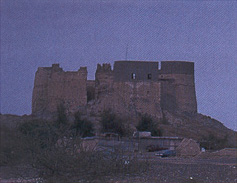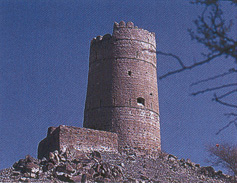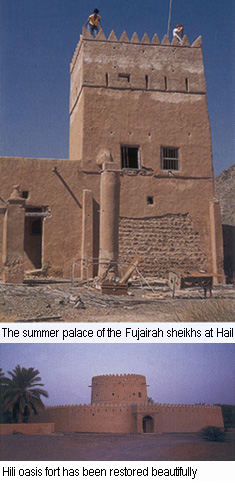|
One
of the first forts I saw in the United
Arab Emirates was the fort of Dibba. It
has long since disappeared, its mud-brick
walls eroded by winds and worn down by
rain. In the early nineteen eighties there
was not much awareness of the importance
of saving the national heritage.
Fortunately that has changed and the last
decade has seen the restoration of many
forts and towers scattered throughout the
country.
The
most famous of the UAE forts must be the
White fort (al Husn) in Abu Dhabi. It
was built on the island in 1793 on the
site of the only freshwater well. It is
an impressive building covering 6400
square meters and fortified with 4
towers. For many years it stood alone
amongst beduin tents and low huts
of barasti. It underwent various
renovations and was finally restored
into its present state in 1995. It is
being used as an administrative
building.
The Al
Fahidi fort in Dubai stems from about the
same time; built in 1799, it has guarded
the southeast entrance to Dubai. It was a
residence and government headquarters till
1896, after which it became an armory and
jail. It was constructed from coral/shell
stones and mud, with palm trunks tied
together forming the ceilings. It has two
round towers, called 'burj' and one
rectangular tower called 'moraba'ah'.
Since 1971 it has been in use as a museum
and it was totally renovated in 1993.
Through a wide entrance guarded by
impressive canons one gains access to the
courtyard, which has some boats and a 'barasti'
dwelling on display. The wind tower of the
hut is very effective, and worth checking
out on a hot summer day. It gives an idea
how inventive people were in order to be
comfortable in the days before electrical
air-conditioning. The right side of the
courtyard used to be the fort armory and
it still continues more or less as such
with a display of many old weapons. The
other museum rooms are below ground in the
new addition that lies below the open
space on which a complete wooden dhow
is on display.
The
exhibits in the museum are
state-of-the-art dioramas of life in the
emirate before oil. The sound effects of
carpentry and copper hammering, of
recitations by children in a madrasa,
and the smells of spices make it hard to
believe that this is not a real suq.
Other rooms show a plantation with a
running irrigation channel (falaj),
beduin life in the desert and even
a camel plodding along a small lane. This
is a taxidermy specimen of a real camel
that the author saw being made at the time
of the renovation of the museum. The
taxidermy artist at the time gave it a
touch of "real life" when he stuck a dead
fly in the corner of one of the eyes of
the camel. However, someone must have
shooed that fly away, for the last time I
checked it was not there any more. The
last room is dedicated to the pearl diving
industry that gave Dubai its wealth in the
days before oil. Back on ground level,
there are rooms with more conventional
displays of archeological finds.
The
other fort in Dubai is the Naif fort that
guarded the northern entrance into Dubai.
It was built in 1939 of coral/shell stones
and gypsum and covers 2000 square meters.
It functioned as a defense tower till 1956
after which it became the police
headquarters and jail. Restored in 1997,
it still serves as a police station.
The fort of Ras al Khaymah is from an
earlier date. It was built in 1749 and
served as a residence for the Al Qasimi
family until 1964, after which it was a
jail till 1984. At that time it was fully
renovated and turned into a museum. I
always like to visit it because of its
authenticity and special atmosphere. The
entrance, guarded by a couple of canons,
is narrow and winding, designed to make it
difficult for intruders to enter. It gives
way to a cobbled courtyard, shaded by a
sidr tree. The stones used for the
cobbling come from the nearby mountains
and some still contain nice shell fossils.
Since the Ras al Khaymah area is very rich
in archeological sites, it is logical that
most of the exhibition rooms are dedicated
to the many items that have been found in
the various digs. My favourites are the
many square and round soapstone containers
with lids, but some of the jewellery is
also very interesting. There is also a
small natural history collection, mainly
shells, for which the emirate's beaches
are famous. A winding staircase with
uneven steps leads to the second story,
where two rooms are filled with clothing,
household items, weapons and documents.
Among the latter I always like to read the
report of Vasco da Gama on his journey
along the coast of this region. He
describes the Batinah coast, Dibba and
Khor Fakkan as well as Julfar, the
bustling trader's city that used to lie
just north of present-day Ras al Khaymah.
|

Fujairah fort before the
reconstruction |

The watchtower at Ghayl |
The
main fort in Sharjah was built in 1820
and consisted of two floors with two
towers. Almost the whole building,
except for one tower, was completely
demolished in the second half of the
twentieth century, and it is only thanks
to the present Ruler of Sharjah that it
was possible to rebuild the fort. When
the old building was being demolished,
Sheikh Sultan kept records of dimensions
and materials while he made descriptions
of what the building looked like, so
that he was able to order the
reconstruction of the fort when he
became a Ruler later on. It was restored
in 1997 and is now a museum that holds
mainly heritage items - jewellery,
clothing, weapons, coins, etc. With so
much effort having been put into giving
this fort a second life, and in view of
the many tourists that come and see it,
it is a pity that the signs that
describe the exhibited items are in very
poor English. It is an unnecessary
distraction from an otherwise
interesting exhibition.
The oldest
fort in the UAE is that of Fujairah, which
was built in 1670 on a high strategic
hill. It was both, a defensive building
and a residence for the ruling family.
With three stories it rises high above the
surrounding flat gravel plain and for
several centuries it was the only stone
building along that stretch of the coast.
It has two round towers and one square
one. Its restoration took a long time and
was finished about four years ago.
Contrary to the other forts it is not
being used as a museum. The Fujairah
museum is housed in a modern building
nearby.
The Ajman
fort is also old and impressive - the city
was probably more important in the old
days than it is now. It covers 2500 square
meters and has 2 round and one rectangular
tower. Built of coral stones and wood it
served as the government headquarters and
the residence for 11 rulers from 1775 till
1981. After two years of restoration work
it was turned into a heritage museum.
Besides the usual household items and
weapons, it also has an interesting
collection of dried medicinal herbs.
The Umm al Quwain fort dates from 1876 and
is square in shape with two entrances, the
main one towards the northwest. Built of
coral, palm tree wood, chandal and gypsum,
it was the government seat until it was
restored recently and turned into a
museum.
 Al Ain
has probably the highest number of
forts, the most impressive of which is
the Al Jahili fort, built in 1889 as a
defense tower and residence. It was
originally constructed from mud bricks
and palm tree wood and was restored in
1990. Its walled enclosure contains a
freshwater well, and a small fort on the
western side with decorated arches and a
spiked door. On the southern side of the
enclosure there is a round fort and a
watchtower, while two circular towers
guard the entrance to the complex. Al Ain
has probably the highest number of
forts, the most impressive of which is
the Al Jahili fort, built in 1889 as a
defense tower and residence. It was
originally constructed from mud bricks
and palm tree wood and was restored in
1990. Its walled enclosure contains a
freshwater well, and a small fort on the
western side with decorated arches and a
spiked door. On the southern side of the
enclosure there is a round fort and a
watchtower, while two circular towers
guard the entrance to the complex.
Other
forts are the Murabba fort, also called
the Police fort, as it served as police
headquarters and jail for long time.
This is located in the business centre
of the town, near the suq, and is
surrounded by an ornate wall. Close by
is the Eastern fort, with the National
Museum on its grounds. This fort was
built in 1910 and is the birthplace of
the President of the UAE, His Highness
Sheikh Zayed bin Sultan al Nahayan.
The
Rumeilah fort lies in the northern
suburbs, close to some major archeological
sites, while the Muwaji Fort lies within a
date plantation (nakhl) and
consists of the main fort with its three
towers and a mosque with a free-standing
minaret. The Hili fort also lies at the
edge of the oases. It is a large round
fort with a round central tower and a very
ornate entrance, which was recently
reconstructed. Finally there is the
Mujarib fort that has a main building and
a smaller fort with a watchtower, nowadays
surrounded by a recreational park. The
main fort has an interesting narrow,
winding staircase that can only be
appreciated if one has brought a torch.
Some
very beautiful restoration work has taken
place at Mazyad fort at the foot of Jebel
Hafit. The reconstruction of the towers
and parapets with original mud bricks is
worth a visit.
Hatta
has a fort and two separate towers, all
built in the late 1800's of mountain
stones and mud bricks. The towers are
round and have an interesting feature: the
entrance is 2.5 meters above ground level
and a rope was used to climb in. Pulling
up the rope prevented any unwanted
visitors from entering.
Another
inland fort is the fort at Bithna that
lies in the middle of a green oasis
against a backdrop of the Hajar Mountains.
It has not yet been renovated and it is
hoped that this will soon happen so that
it does not suffer the fate of the mud
fort at Hala, which has deteriorated so
much over the past decades, that only a
few small parts of the wall are standing,
still showing the intricate decorative
designs of the majlis walls.
The other fort that has sadly fallen into
disrepair is the summer residence of the
rulers of Fujariah, al Hail fort. Over the
years that I have visited this place more
and more of the doors and windows have
disappeared, the access to the top floors
of the towers has become dangerous and it
is now only a ruin. Still, many beautiful
details still remain - the palm tree trunk
ceilings, the crenellated decorations and
the handprints on the walls, which are the
'signatures' of the workers who built the
palace.
A large
numbers of defensive towers dot the
landscape of the UAE. Just to name a few:
Bakhoo tower, Al Jazirah, Al Hamra tower,
Al Bedriah tower, Al Maqta tower, Al Khan
tower, Nahar tower and the tower of Ghayl,
near Khor Kalba. Some have been taken care
of, others are hanging on for dear life.
Most of
the forts can be visited at any time,
although those in use as museums have
specific opening hours. In some cases
access has to be arranged with a watchman
or with the municipality.
All the forts and watchtowers are
indicative of a past, in which violent
attacks were the order of the day and
people needed the refuge of the stone
walls to save their lives from marauding
tribes. Now the only creatures that find
refuge in them are the various species of
bats that feed around city lights or in
the plantations.
 |
